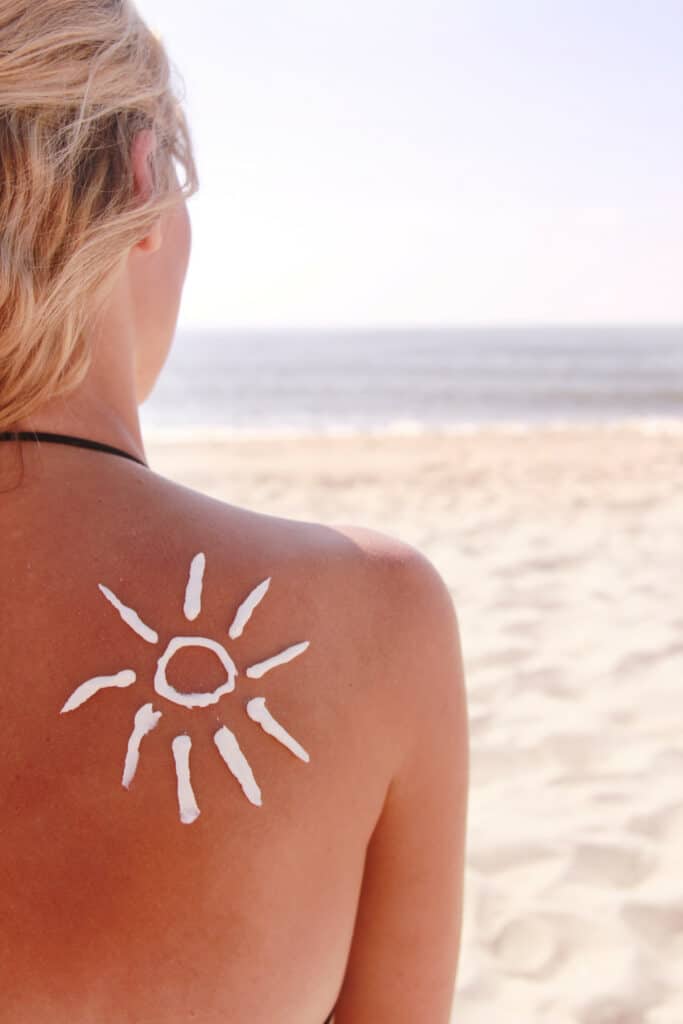
When you’re out catching waves, the sun can be a surfer’s not-so-friendly companion. Too much sun exposure is a major player in skin cancer and speeds up the aging process. Once your skin takes a hit, there’s no turning back, so it’s crucial to protect it pronto.
Here are 9 easygoing tips to keep your skin in check. Let’s kick it off with some sunscreen.
1. Use higher than SPF(Sun Protection Factor) 30, broadspectrum, water-resistant sunscreen.
The UV rays that mess with our skin aren’t something we can see or feel, but they go by the name UV radiation. Broadspectrum sunscreen is the superhero that blocks these sneaky UV rays. SPF 30 can fend off 96.7% of them, while SPF 50 takes it up a notch to 98%.
This sunscreen is the chemical type, doing its thing by absorbing UV radiation and tossing it out as heat once it’s in your skin. Just be patient, though – it takes about 20-30 minutes to dive into the deep layers.
Down under in Australia, the UV is strong, and it takes a mere 11 minutes for the sun to give you a sunburn. So, slap on that sunscreen before you step out, because if you wait until you’re already on the way to surf, it won’t have enough time to soak in, and most of it will end up taking a dip in the ocean.
Note on ocean pollution.
So, here’s the catch: chemical sunscreens are toxic to our coral reefs and underwater buddies like algae and sea urchins. These little guys are the unsung heroes of the ocean ecosystem, and if they’re in trouble, it’s bad news up the food chain.
Now, you might have heard about organic products claiming to be completely biodegradable sunscreen. But, we’re not entirely sure how much harm those supposedly friendly natural vegetable oils might be causing to our coral reefs. We need some more info and clarification on that front.
2. Add Physical Sunscreen.
Now, let’s talk about another sunscreen type: the physical sunscreen, acting as a protective shield for your skin. The main ingredient here is zinc oxide, known to be gentle on both your skin and the reef.
When looking for a sunscreen with zinc oxide, opt for the non-nano variety. This ensures that the particles are larger, preventing sea creatures from ingesting them.
Here’s the kicker, though – there’s no official reef police out there. So, it’s on you to double-check that the ingredients steer clear of reef-harming stuff, like Benzophenone (Oxybenzone )1
Pros:
Compared to chemical sunscreen, it stays on your skin well while you surf.
Safe for reef and marine life.
Cons:
It gets pretty greasy, making it a challenge to wash off. If you’ve got oily skin, it can lead to issues like pimples. Plus, applying it with your hands and accidentally getting it on your board turns it into a slippery situation – turtle rolls, pop-ups, and duck dives become quite the struggle.
My suggestion? Grab a sunscreen stick to skip the hand application hassle. If that’s not your style, apply it at home and make sure to wash your hands with soap before hitting the beach.
3. Wear long sleeve wetsuit.
Wearing long sleeves during the summer months is one of the best ways to protect your skin. You do not have to apply sunscreen wherever the wetsuit covers, making it much easier.
When wearing a wetsuit top, beware of the gap between the wetsuit top and board shorts. wetsuit tops tend to come up slightly when surfing, exposing the skin just above the board.
Therefore exploring alternative wetsuit designs, such as spring suits with extended arms or long-legged variants, may present more viable options for comprehensive skin coverage.
Pros:
Great sun Protection.
Cons:
Might get a bit too warm in tropical climates.
Long-sleeved wetsuits can feel a tad tighter than their short-sleeved counterparts or going without one altogether. However, that snug sensation tends to ease up, and you get used to it over time.
Tips: Don’t judge the wetsuit too quickly when you trying in the shop. When the wetsuit is wet, it stretches a little bit more.
4. Wear Surf-hat.
There are hats specifically crafted for surfers, with various designs available. Surf hats come in different styles such as caps, buckets, and those with a neck flap.
Upon initially wearing a hat, you’ll notice a quick change in your vision, particularly the peripheral view crucial for checking out fellow surfers and waves. In my experience, the cap-style hat tends to be the most comfortable and obstructs less vision.
Certain surf hats even come with detachable back flaps. If your wetsuit already covers your neck well, you might consider removing the flap for added comfort.
Pros:
Great sun protection for your facial skin and also for your eyes.
Surf hats rarely come off thanks to the strap that goes around the chin.
Cons
Surf hats block vision. It’s difficult to check upcoming waves and the surroundings.
It feels slightly restrictive under the chin or neck where the strap is.
When duck diving, or falling off the wave, water goes inside the hat making it uncomfortable. However, it drains out pretty quickly.
5. Don’t be fooled by cloudy days.
Even on cloudy days, when it may not feel as scorching or irritating to the eyes, it’s important to note that harmful UV radiation still penetrates. Studies suggest that as much as 80 percent of harmful UV radiation can pass through clouds.
Additionally, during the winter months when the sun is closer to the Earth, UV exposure remains a concern. This is particularly relevant for surfers, as UV rays reflect off water and sand, intensifying the risk of exposure.
Given these factors, surfers should exercise extra caution and prioritize sun protection, even when the weather might suggest otherwise.
6. Avoid 9 am-5 pm during summer days.
The peak of harmful UV radiation occurs between 9 am and 5 pm. If you have the flexibility to choose your surfing time, opting for early morning sessions or those after 5 pm can help minimize exposure.
Note that UV rates are not only related to the time of the day. For accurate measures of UV, you can download the UV index App here for Australia and here for the USA.
7. Gradually expose yourself to the sun
Excessive sun exposure can lead to sudden burns. To prevent this, consistently apply sunscreen and allow your skin to gradually develop a tan over time.
By adhering to the mentioned guidelines, you can likely steer clear of burns. Nevertheless, it’s worth noting that some individuals may not develop a tan and are prone to sunburn despite taking precautionary measures.
8. Moiturise your skin post-surf.
When you surf, your skin will be exposed to the sun, wind and salt. A combination of these will reduce the amount of water in your skin, making it dry.
Saltwater alone will cause your body to lose water gradually over time. So, even surfing in the rain can make your skin and body dry.
When it comes to moisturising, there are almost too many options. Not being a skin expert, it’s difficult to recommend types. I suggest you do your research and find a suitable cream.
9. Wear eye protection when you can.
UV rays can harm our eyes, necessitating protective measures. However, surfers commonly forgo eye protection for two main reasons.
Firstly, conventional eye gear tends not to stay securely in place. Even with swimming goggles, a decent wipeout can dislodge them, presenting a significant hindrance. Personally, I haven’t come across goggles specifically designed for surfers.
Secondly, the lack of widespread adoption contributes to the reluctance. As social beings, most surfers prefer not to stand out. In my decade-plus of surfing, encountering individuals wearing goggles or sunglasses has been a rare occurrence.
As an alternative to shielding the eyes, wearing a hat serves as a means to reduce UV exposure. Nonetheless, opting for eye protection during surfing is acceptable. Safety takes precedence, so ensure the lenses are polarized for optimal protection.
Reference

